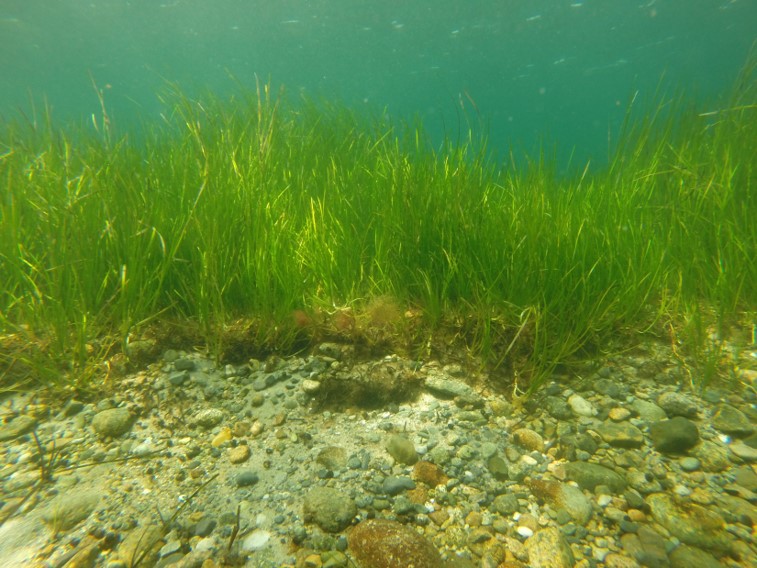Healthy Lawns, Healthy River
Welcome to Healthy Lawns, Healthy River.
The Niantic River Watershed Committee is encouraging residents who live on or near the shore of the Niantic River, tributary streams (Latimer Brook, Oil Mill Brook, and Stony Brook), and Long Island Sound to reduce or eliminate the amount of fertilizer being applied on lawns in order to maintain the health of the Niantic River.
Fertilizer has been identified as one of the most significant threats to the health of the Niantic River. Scientists conducting research in Long Island Sound bays and harbors have determined that in the Niantic River watershed, about 28% of the nitrogen in the river comes from fertilizer (1).
Nitrogen, a key component of fertilizer, is a plant nutrient. Nitrogen is very mobile; it dissolves readily in water, which means it is transported easily into the soil to reach the roots of plants. Unfortunately, it also means that it is easily dissolved in runoff, whether it be from a rainstorm or a sprinkler system. It also travels readily through the soil into the groundwater table. When excess nitrogen from fertilizer is carried into storm drain systems or soaks into the groundwater table, it may ultimately reach the Niantic River and Long Island Sound. There, it feeds aquatic plants such as seaweed and algae. This can result in unsightly and unhealthy algae blooms, which reduces water clarity, preventing sunlight from reaching important aquatic plants like eelgrass. Excess nitrogen also promotes the growth of seaweed, which can create monocultures and smother the river bottom.

NRWC is asking homeowners to adopt simple actions while they conduct their lawncare that are healthy for their lawns, and healthy for the Niantic River.
A Lawn Care Guide for a Healthy Yard and a Healthy Niantic River
Click on the brochure to download a PDF (You will need Acrobat Reader).
A recent survey conducted by The Nature Conservancy reveals that nearly 75% of homeowners in the area are willing to reduce the amount of fertilizers they use for a healthy Niantic River (2).
In 2018, the Niantic River Watershed Committee partnered with the Long Island Sound Study and The Nature Conservancy to promote lawn care practices that are healthy for lawns and the Niantic River. These practices were identified by turf scientists at universities throughout New England, including the University of Connecticut (3).
In 2021, NRWC is expanding the pilot study to encourage homeowners throughout the Niantic watershed to reduce the amount of fertilizer they apply for a Healthy Niantic River.
Here are practices recommended for New England lawns to help reduce the amount of lawn fertilizer that enters the Niantic River.
- Leave grass clippings on the lawn. Grass clippings decompose quickly, providing natural, slow-release nitrogen for a lush, healthy lawn. Mulching mowers clip grass into small pieces that disappear into the lawn and decompose quickly. If you use fertilizer, leaving grass clippings on the lawn may allow you to reduce the amount of fertilizer you use.
- Don’t apply fertilizer, or if you do, apply 1/3 to 1/2 the amount recommended on the fertilizer bag. If you do not use fertilizer and are happy with the way your lawn looks, there is no need to start fertilizing. If you use fertilizer, especially on a well-established lawn, turf scientists recommend applying 1/3 to 1/2 the amount recommended on the fertilizer bag. After two weeks, if you are satisfied with the way your lawn looks, you have applied the right amount. If you are not satisfied, apply a little more.
- Apply fertilizer at the right time – close to Labor Day and/or Memorial Day. Timing is everything! Applying fertilizer before your lawn can efficiently absorb it (before April, during the hot summer months when grass is dormant and after mid-October) is a waste of fertilizer and money. Unused fertilizer can leak into groundwater and wash into the Niantic River. In our area, if you fertilize once a year, it is best to do so around Labor Day in the fall or Memorial Day in the spring. If you fertilize twice a year, those dates are also the best time to allow the grass to efficiently absorb fertilizer.
More tips for a healthy lawn:
- Mow at least three inches high to encourage deeper, healthier roots.
- Choose grasses such as fescues that require less water and fertilizer.
- Avoid over-watering and do not fertilize if a heavy rain is forecast.
- Avoid using combination products such as weed-and-feed control, which can lead to the over-application of fertilizer. Apply weed control products separately at the recommended time.
- Don’t Guess – Soil Test! Get your soil tested to see if soil nutrients are adequate or if additional nutrients or limestone are needed. Soil tests can be obtained from the University of Connecticut Soil Lab (available at the UConn New London County Extension Center) and the Connecticut Agricultural Experiment Station.
For more info on healthy lawns and healthy rivers visit:
Long Island Sound Study Sound Gardening
Connecticut’s Second Generation Nitrogen Strategy
Citations:
(1) Comparative analysis and model development for determining the susceptibility to eutrophication of Long Island Sound embayments. 2015. Jamie Vaudrey, Charlie Yarish, Jang Kyun Kim, Chris Pickerell, Lorne Brousseau with Justin Eddings, Veronica Ortiz Tanguay, Claudia Koerting, Michael Sautkulis. University of Connecticut.
(2) Niantic River Attitude and Awareness Study, The Nature Conservancy. 2017.
(3) New England Regional Nitrogen and Phosphorus Fertilizer and Associated Management Practice Recommendations for Lawns Based on Water Quality Considerations – Revised 2017.
Karl Guillard and Thomas F. Morris (editors), University of Connecticut.
The 2021 Healthy Lawns, Healthy River for the Niantic River and Long Island Sound project is funded by a grant from the Long Island Sound Futures Fund.
The 2017 pilot project was funded in part by the New England Interstate Water Pollution Control Commission, the Dominion Energy Charitable Foundation, and the Eastern Connecticut Conservation District.

